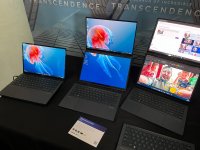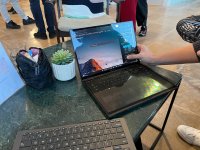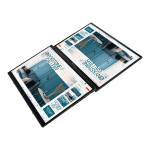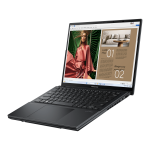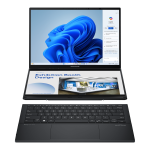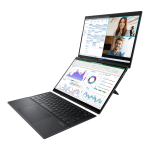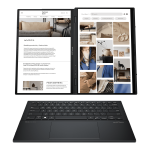A brief hands on with ASUS' latest dual-screen laptop
Packing two 16:10 aspect ratio 3K OLED displays running at 120Hz at its highest spec, along with a detachable keyboard, built-in kickstand, and reasonable IO (2x Thunderbolt 4, 1x USB 3.2 Type 1, 1x HDMI 2.1), I think I’m justified in my enthusiasm. The latest Zenbook Duo has finally been announced, and I can finally talk about my fleeting time with it. Obviously this isn’t ASUS’ first stab at a dual-screened design though and it was interesting to see their history on show next to the latest model, including a prototype that never made it to market. I’m a personal backer of multi-screened tech, with the Zephyrus Duo catching my eye in 2022 and being a device I’ve loved using since. There were compromises made to house the secondary display there, but I could accept them. The keyboard was full-sized, but pushed down. The trackpad was large enough and easy to reach, just in a place that’s not too common on a laptop. These design quirks are gone.
The way the latest Zenbook Duo works is pretty fun. You have both halves of the laptop clamshell housing a screen, with a detachable Bluetooth keyboard sandwiched between them. The keyboard itself can be connected to the laptop using pogo pins, and held in place with magnets. When it’s on the laptop like this, you have a fairly accessible single-screened system that just feels like your every day laptop. Aesthetically-speaking, I get a real ThinkBook feeling. Remove that keyboard though, and you’re treated to a secondary display with absolutely no compromises. The keyboard pairs automatically to the system too, switching over to Bluetooth with no hassle. It’s about as seamless as you could hope it to be. The second screen is detected in-software and connects just like any other display.
Both screens have an identical spec, making the larger experience feel really great regardless of the screen you’re choosing to look at. And with the built-in kickstand, it’s really easy to get the system setup to a comfortable angle while at a desk. Having had the system in-hand, I was quite surprised to see just how strong that kickstand was. I could comfortably hold the system by it and shake it around without anything breaking or noticeably going wrong; the ASUS rep that was sat with me didn’t even look concerned, which was a surprise. I'm slightly annoyed at myself for forgetting to get a picture of the kickstand itself, since it isn't quite as clean an implementation as what you've seen from devices like the Surface or even the OLED Switch. It's functional and sturdy, but it looks a little out of place.
The ScreenXpert software appears to have seen some improvements too, though I didn’t get to see everything. ScreenXpert is ASUS’ special sauce for their systems with multiple displays, giving you easy access to configurable app groups to open together, or other useful things like virtual trackpads and keyboards. What I’m particularly interested in though is ScreenXpert’s ability to launch an app over multiple screens on a system. It doesn’t sound like all too exciting a feature, and it's not one I used particularly often on the Zephyrus Duo, but it does address something I’ve been wanting for a long long time: DS emulation over multiple screens. I obviously couldn’t ask them to download MelonDS while I was there, but I have high hopes. We might not have an emulator that supports splitting screens into multiple windows yet, but there may yet be a niche solution… At a price, of course.
These multi-screened laptops are never particularly cheap, and this one isn’t much of an exception with a starting price of £1700 in the UK. Though notably cheaper than Lenovo’s take on a similar system (the Yoga Book 9i starting at £2240 via Lenovo’s official site at the time of writing) it’s still a good chunk more than you’d be paying for a system of similar spec sans the additional screen. I only spent an hour or so with it so I obviously can’t offer any long-term thoughts here, but this is a device I’m really excited to spend more time with. With some luck we’ll be able to get a device on loan for further coverage, but failing that it’s really likely I’ll be going out to buy one myself when it's expected to release at the end of January. These designs are just so fun, and I really love talking about them. With Intel’s latest Ultra 5, 7, or 9 inside, it’ll likely be a decently-performant ultrabook, and it being tested to last 10 hours of battery life with both screens on playing HD video just gets me fired up more.
Though ASUS have shown their hand, CES will be running until Friday this week, so there may yet be more fun announcements to come. Have you been following CES? Are you just as excited for interesting tech like this, or would you prefer more affordable systems that just stick to the basics? Let me know your thoughts.
